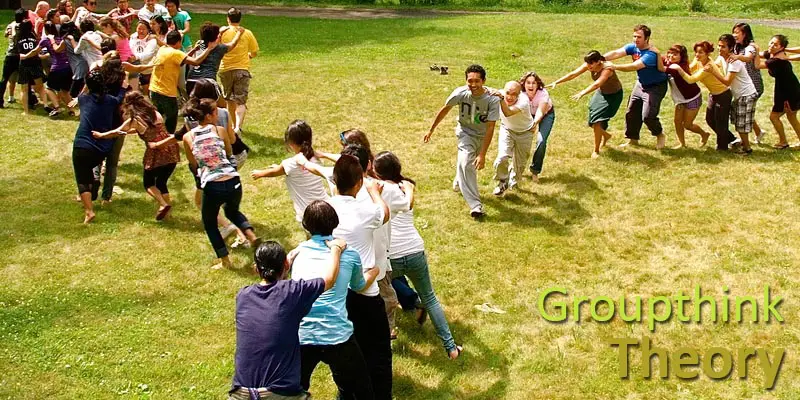‘Group think’ is a process where certain number of people come together with unanimous decisions that concerns the whole group and decide a possible course of action. These groups come to situations where they have to decide between unanimity (agreement by all people involved) and objective solution and they go for unanimity rather than going for other options. Here, the other options might be more beneficial but they choose to be united to avoid conflicts or due to group pressure. Group cohesiveness also increases group think. The need of unanimity is taken seriously because motivation and satisfaction of the members is important for dedicated workforce.

The term “Groupthink” was coined in 1972 by a social psychologist, Irving Janis, to learn how group decisions are made and how group decisions could be successful or a failure. He made his conclusions based on studies on American Soldier Project and U.S. foreign policy decisions, which included the Japanese attack on Pearl Harbor of 1941, the Bay of Pigs invasion of 1961 and the beginning of Vietnam Wars(1964 to 1967). He concluded that in all these events, the decisions were made through groupthink. The theory is not only applicable to political decisions but also in any other decision making and communication processes.
Concepts in Groupthink Theory
Group pressure is known to deteriorate decision making power, mental efficiency and moral judgment. To dehumanize competing groups, they take irrational actions and decisions. Commonality in groups increase due to similar backgrounds, less criteria or rules. The decision is worsen by outside opinions or too many brains working for the same thing creating many opinions and confusion.
How the decision is put across to the group members or how it is communicated is also important to decrease dissatisfaction between people. Groupthink is a concurrence seeking behavior. People do not consider alternatives, ignore their own objectives, do not assess risks, are bias in selection, do not have backup plans and therefore have communication breakdown and unsuccessful outcome.
Groupthink can be lessened by good and effective communication between group-members, avoidance of leader’s opinions taking over, healthy discussions, taking anonymous surveys, etc.

Symptoms of Groupthink
The major symptoms of groupthink according to Irving Janis are:
- Illusion of invulnerability– This is related to extremism which encourages people to take bigger risks.
- Collective rationalization– Thinking of one person as correct confidently reduces rational thinking of all.
- Belief in inherent morality– When people think they are doing something moral, they do not consider morality of the process as well as consequences.
- Stereotyped views of out-groups– Out-groups are viewed as enemies and their views are always taken as negative and are ignored.
- Direct pressure on dissenters– All members of a group have a feeling of group feeling. They think that if they put forward any views different from other members, it can cause conflicts.
- Self-censorship– People censor their own feelings and its communication to avoid conflicts and disagreements.
- Illusion of unanimity– Group members think that they believe in the same cause and therefore in all the decisions related to the cause, which builds a false sense of unanimity.
- Self-appointed ‘mind-guards’– Mind guards itself from conflicting situations which makes people remain far from contradictory thoughts, actions and communications.
Features of Groupthink Theory
- Groupthink is a process of thinking and a mode of thinking.
- People have a nature and tendency to be unanimous, consensus seeking and avoid conflicts.
- Groupthink impairs creativity and moral judgment.
- Groupthink suppresses good planning.
- It shows that communication breaks down under group and social pressure.
- It shows how communication can act as a bridge to decrease groupthink behavior.
- Groupthink is more in close-knit groups.
- Critical thinking is impaired and bias decisions are made.
Examples of Groupthink Theory
Janis had studied the Bay of Pigs Invasion fiasco of 1961 before making the theory of group think. The Bay of Pigs invasion failed, according to Janis, due to the Kennedy government making a group decision to support the exiled Cuban political party led by Fidel Castro, which was overthrown in 1960, to invade Cuba again with the help of CIA. The invasion failed ultimately. Kennedy had decided on that because of his group of advisor’s who did not advice anything against his wrong decisions as Kennedy was making good decisions on other things related to the U.S. government. Kennedy had asked the advisors to vote for or against the decision. All the group members believed in Kennedy’s decision and did not use their own rationality even though the invasion did not have any probability of success.
The same thing happens in all small situations like a group of students deciding on an academic group project, a team of football players during a match, a board of directors of a company deciding on the future of company, etc. When people do not communicate what they have to for betterment of anything, the communication fails and group cohesiveness might also not remain intact.
Criticisms of Groupthink Theory
- Negative outcomes are common by groupthink.
- Leaders get more power due to groupthink.
- Dissatisfaction occurs within groups due to failure.
- It discourages critical evaluation.
- It also does not promote people from taking initiatives.
- Ideas become stale by same kind of decisions.
- Risks are not thought about.
- Alternatives which can be better is ignored.
